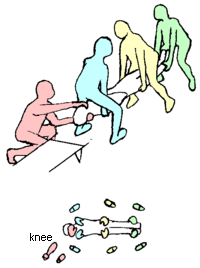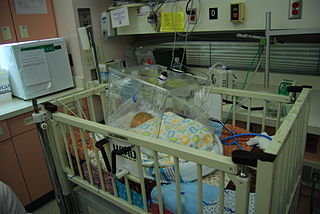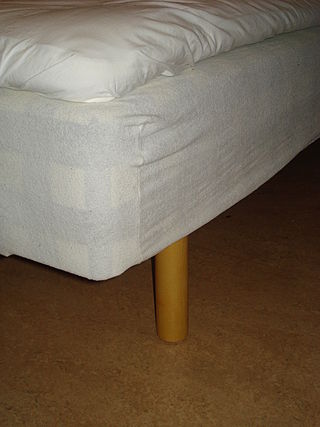Related Research Articles
Activities of daily living (ADLs) is a term used in healthcare to refer to an individual's daily self-care activities. Health professionals often use a person's ability or inability to perform ADLs as a measure of their functional status. The concept of ADLs was originally proposed in the 1950s by Sidney Katz and his team at the Benjamin Rose Hospital in Cleveland, Ohio. Since then, numerous researchers have expanded on the concept of ADLs. For instance, many indexes that assess ADLs now incorporate measures of mobility.

A futon is a traditional Japanese style of bedding.

An air mattress is an inflatable mattress or sleeping pad.

A stretcher, gurney, litter, or pram is an apparatus used for moving patients who require medical care. A basic type must be carried by two or more people. A wheeled stretcher is often equipped with variable height frames, wheels, tracks, or skids.

Bedding, also called bedclothes or bed linen, is the materials laid above the mattress of a bed for hygiene, warmth, protection of the mattress, and decorative effect. Bedding is the removable and washable portion of a human sleeping environment. Multiple sets of bedding for each bed are often washed in rotation and/or changed seasonally to improve sleep comfort at varying room temperatures. Most standardized measurements for bedding are rectangular, but there are also some square-shaped sizes, which allows the user to put on bedding without having to consider its lengthwise orientation.

A vacuum mattress, or vacmat, is a medical device used for the immobilisation of patients, especially in case of a vertebra, pelvis or limb trauma. It is also used for manual transportation of patients for short distances. It was invented by Loed and Haederlé, who called it "shell" mattress.

Casualty lifting is the first step of casualty movement, an early aspect of emergency medical care. It is the procedure used to put the casualty on a stretcher.

A bed is an item of furniture that is used as a place to sleep, rest, and relax.

A bed sheet is a rectangular piece of cloth used either singly or in a pair as bedding, which is larger in length and width than a mattress, and which is placed immediately above a mattress or bed, but below blankets and other bedding. A bottom sheet is laid above the mattress, and may be either a flat sheet or a fitted sheet. A top sheet, in the many countries where they are used, is a flat sheet, which is placed above a bottom sheet and below other bedding.

A hospital gown, sometimes called a johnny gown or johnny, especially in Canada and New England, is "a long loose piece of clothing worn in a hospital by someone doing or having an operation". It can be used as clothing for bedridden patients.
Suicide watch is an intensive monitoring process used to ensure that any person cannot attempt suicide. Usually the term is used in reference to inmates or patients in a prison, hospital, psychiatric hospital or military base. People are placed on suicide watch when it is believed that they exhibit warning signs indicating that they may be at risk of committing bodily harm or purposefully killing themselves.

An oxygen tent consists of a canopy placed over the head and shoulders, or over the entire body of a patient to provide oxygen at a higher level than normal. Some devices cover only a part of the face. Oxygen tents are sometimes confused with altitude tents as used by athletes and those looking to acclimatize to a higher altitude, but those contain a reduced oxygen content.

The Sims position, or left lateral Sims position, named after the gynaecologist J. Marion Sims, is usually used for rectal examination, treatments, enemas, and examining women for vaginal wall prolapse.

A mattress protector is an item of removable bedding that sits on top of, or encases, a mattress to protect it. Some mattress protectors also provide protection to the person sleeping on the mattress from allergens and irritants such as dust mites, bed bugs, mold, and dead skin.
An adjustable bed is a bed which has a multi-hinged lying surface which can be profiled to a number of different positions. Common adjustments include inclining the upper body and raising the lower body independently of each other. Other common features include height adjustment and tilting the bed to raise the upper body or the lower body into the Trendelenburg or reverse Trendelenburg positions.

A patient lift may be either a sling lift or a sit-to-stand lift. This is an assistive device that allows patients in hospitals and nursing homes and people receiving home health care to be transferred between a bed and a chair or other similar resting places, by the use of electrical or hydraulic power. Sling lifts are used for patients whose mobility is limited. Sling lifts are mobile lifts or overhead lifts.

A sleeping berth is a bed or sleeping accommodation on vehicles. Space accommodations have contributed to certain common design elements of berths.

A hospital bed or hospital cot is a bed specially designed for hospitalized patients or others in need of some form of health care. These beds have special features both for the comfort and well-being of the patient and for the convenience of health care workers. Common features include adjustable height for the entire bed, the head, and the feet, adjustable side rails, and electronic buttons to operate both the bed and other nearby electronic devices.
Surgical positioning is the practice of placing a patient in a particular physical position during surgery. The goal in selecting and adjusting a particular surgical position is to maintain the patient's safety while allowing access to the surgical site. Often a patient must be placed in an unnatural position to gain access to the surgical site.

Bed-making is the act of arranging the bedsheets and other bedding on a bed, to prepare it for use. It is a household chore, but is also performed in establishments including hospitals, hotels, and military or educational residences. Bed-making is also a common childhood chore.
References
- "draw-sheet" Archived 2010-02-15 at the Wayback Machine . mondofacto.com. Retrieved 10 October 2010.
- Hegner, Barbara R.; Needham, Joan Fritsch. (2002). Assisting in Long Term Care (4th ed.). Delmar. p. 245. ISBN 0-7668-3479-4
- Carter, Pamela J. (2008). Lippincott's Textbook for Nursing Assistants: A Humanistic Approach to Caregiving (2nd ed.). Lippincott Williams & Wilkins. p. 276. ISBN 978-0-7817-6685-2
- Beebe, Richard W. O.; Funk Deborah L. (2001). Fundamentals of Emergency Care (vol 1). Delmar. pp. 281–285. ISBN 0-7668-1498-X
- Zucker, Elena D. (2009). The Caregiver's Resourcebook (6th ed.). Rex Bookstore. p. 156.